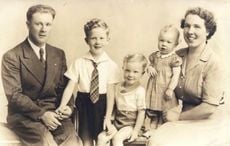| DNA's Double helix |
| Clans fo Ireland - 900 AD |
| Cliffs of Moher, County Clare |
| Uragh - neolithic stone circle in County Kerry |
DNA testing can light pathways back into Ireland’s past; it tells immense stories of deep ancestry, of a time far beyond memory, of lost generations beyond the reach of genealogy or written record. All of the Irish are immigrants who travelled from the east, the south and later, the north to the farthest end of Europe. DNA can trace their origins and often the centuries when they arrived. And those who left Ireland more recently carried these stories inside them, in their DNA, no matter how far from home they travelled. Even on the other side of the wide world DNA can find Ireland’s children and bring them back, tell them where a home before Ireland once was and help them understand that they were not the first of their people to migrate.
Scientists can unlock these secrets by testing for what are known as DNA markers. Each of us inherits six billion letters of DNA, three billion from our mothers and three billion from our fathers. Occasionally tiny errors of copying are made in reproduction and it is these minute changes that are called markers. They arise in particular places at particular times and skilled geneticists can locate a marker’s origin and date its creation. And most spectacularly, by looking at its frequency in modern populations, they can also track the movement of a marker across the face of the Earth.
The last ice age erased all life in Ireland. That means something simple and unarguable; all of the Irish are immigrants. Between c24,000BC and c11,000BC, Ireland was deserted, a frozen, white landscape where nothing, no plant, animal or person could survive. But when at last the weather began to warm and the land greened, animals and the people who hunted them came back. Because it lay on the edge of beyond, Ireland was one of the last places in Europe to be repopulated after the ice melted. And that has caused the Irish to be a more genetically homogenous people, more so than the British and most Europeans.
As the westernmost place in Eurasia, and shielded by the long landmass of Britain, Ireland was prey to fewer invasions. The Romans and their multi-cultural legions and colonists briefly considered the conquest of the large island off the coasts of Britannia, but decided against it. The Angles and Saxons crossed the North Sea after c500 and England and South-East Scotland absorbed them like a sponge. Few ventured further, their momentum spent in conquering Northumbria, Yorkshire and East Anglia. The Danes came after them and settled so densely in Northern and Eastern England it became a separate state, the Danelaw, but nothing like that happened in Ireland. And although Strongbow seized land in Leinster, there was no large-scale invasion such as that led by William the Conqueror in 1066 after his victory at Hastings.
Germanic, Teutonic and Alpine markers are all common in Britain but they have a very low frequency in Ireland at 5%, 2% and 2% respectively. The Vikings may have fought Brian Boru at Clontarf and established a large and notorious slave market in Dublin, but their classic marker, M17, is seen very little in Ireland at 1% to 2%. In Orkney, by contrast, 20% of all men carry it.
What makes Ireland’s DNA fascinating is how much of it glitters with the memories of half-forgotten kings, especially amongst Y chromosome markers, what only men carry. The impact of ancient Celtic dynasties on the Irish genome has been extraordinarily profound. The Ui Neill of the north, the Eoganachta of Munster, Brian Boru’s Dal Cais clan and the ancient chieftains of the Lagin all bequeathed their DNA to many thousands of Irishmen. It happened through a process known, scientifically, as social selection and, bluntly, as the fact that powerful men in Ireland had a great deal of sex with many different women. When linked to the relaxed attitude of Celtic aristocrats to issues of legitimacy and the ancient habit of polygamy, it should be no surprise that the great kings of the past have many modern descendants. St Patrick’s piety and rectitude inhibited these trends a little. Perhaps the most famous, the most prolific and certainly the most impressive royal ancestor was the shadowy figure of Niall Noigiallach, the first High King. He lived in the 5th century and his DNA marker, M222, is massively present now. Around 20% of all Irishmen carry it. And incidentally, his descendants walk the avenues of New York City - a staggering 2% of European American men who live and work in the Big Apple carry the High King’s lineage.
Niall’s marker is also significantly present in Scotland and it marks the path of some of the first emigrants. Warbands of the Ui Neill crossed the North Channel to found the Gaelic kingdom of Dalriada and to bring their language and their bloodlines to Scotland. From the 6th century to 1286, kings with Irish blood in their veins, the great macMalcolm dynasty, ruled Scotland.
DNA has discovered a new and different sort of history, a people’s history and our IrelandsDNA project is finding different narratives to help build a mosaic, an immensely detailed and nuanced story of the Irish. For those who take a test, it can tell them new stories about themselves and their ancient ancestors, stories only DNA can tell.
To find where you fit into the immense sweep of the story of the Irish, go to www.irelandsDNA.com




Comments